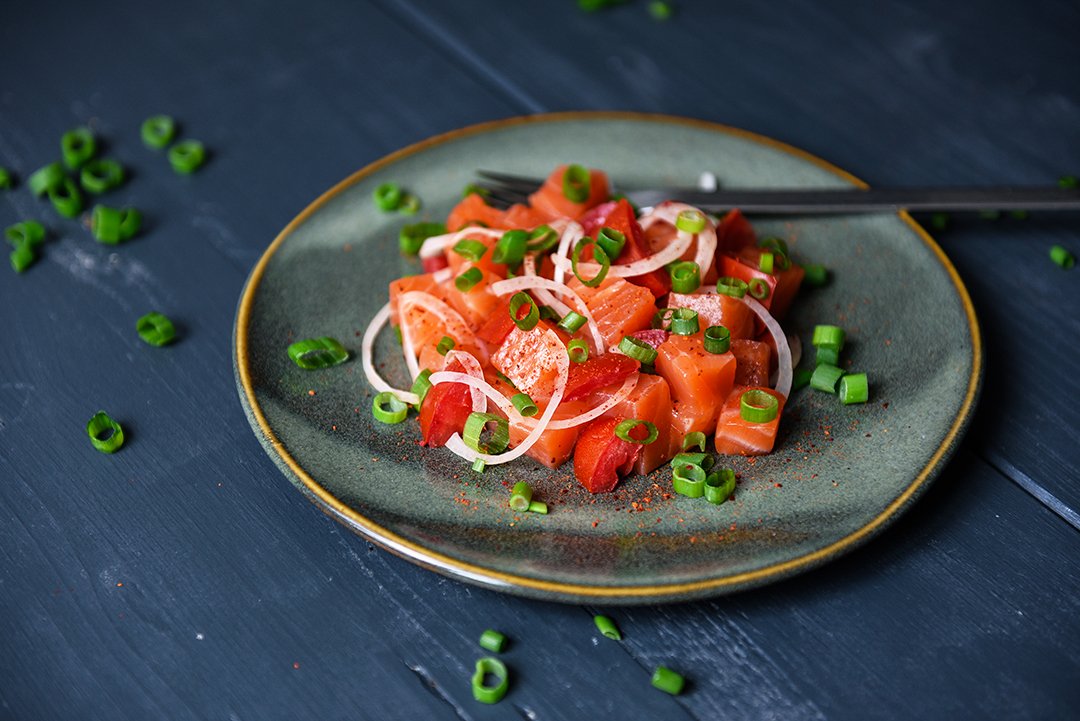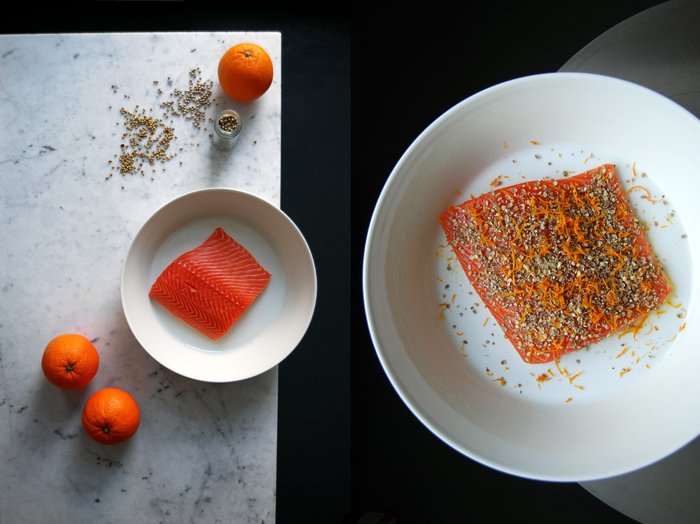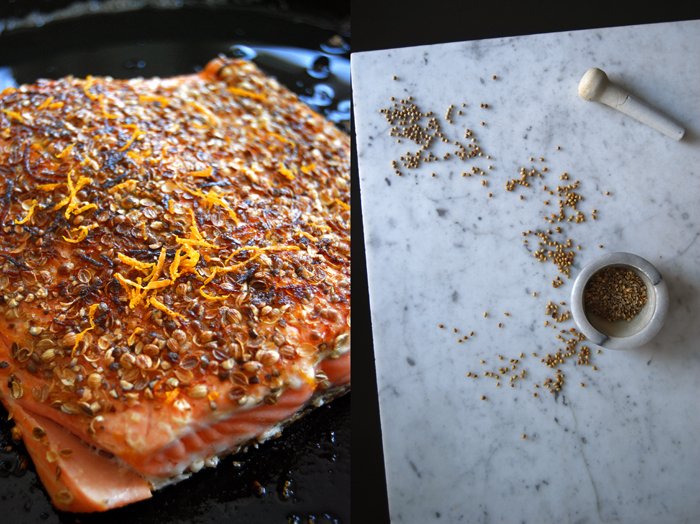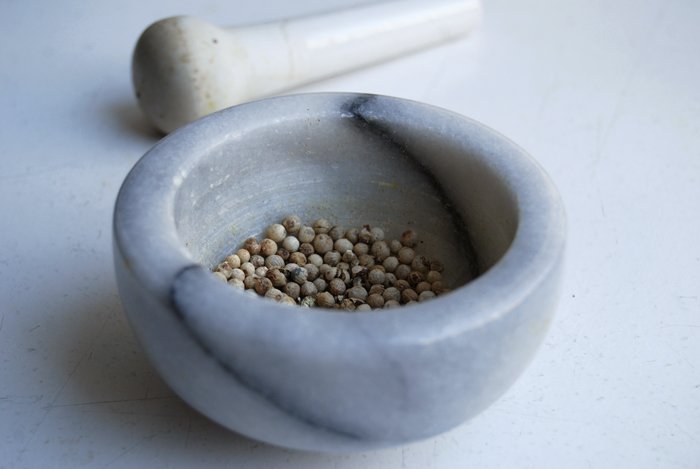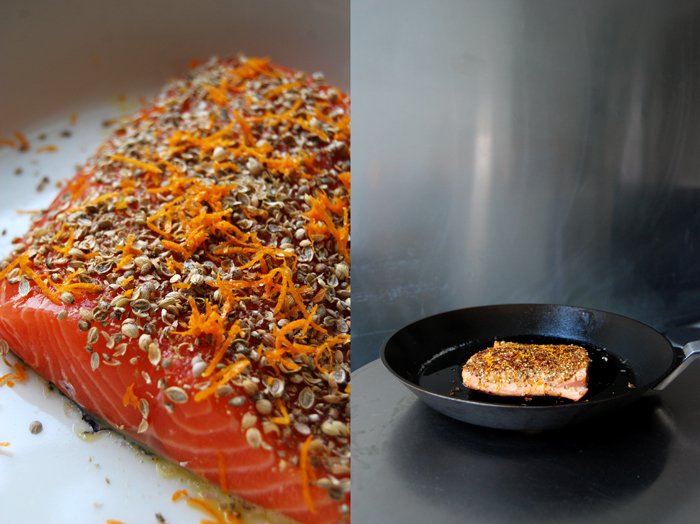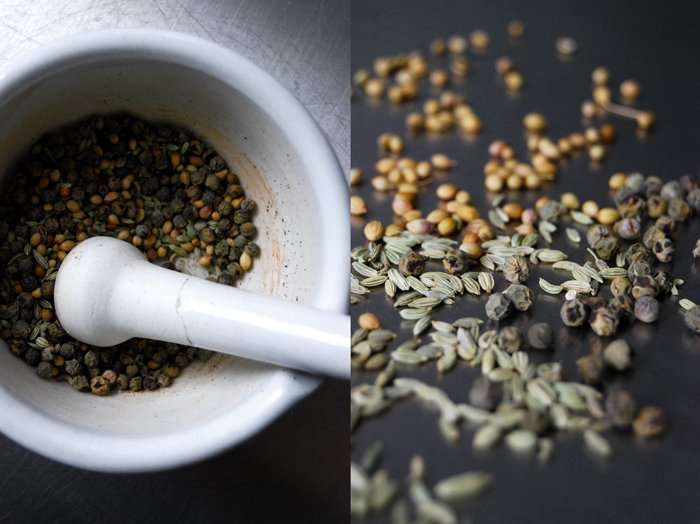Hawaiian Lomi Salmon
My mother makes fantastic gravad lax. It's one of my family's favorite dishes whenever the whole bunch gathers to feast. When I was younger, I would watch her prepare it and it fascinated me how she managed to turn two raw salmon fillets cured only with salt, sugar, dill, pepper, and juniper berries into something so fine and flavorful. After a few days they were firm yet tender, with hints of the sea yet at the same time tasting slightly sweet - it felt like magic. Salt-curing fish was the only way to preserve the daily catch from the sea in the pre-fridge era. It's deeply rooted in various cuisines, and thanks to its taste and texture, oily salmon remained a popular candidate keeping this ancient technique alive. Beyond gravad lax!
Alana Kysar had already introduced me to a new fish recipe when I met her in LA for our Meet In Your Kitchen feature back in 2017. Her Ahi Poke Bowl expanded my repertoire of recipes that use the fruits of the sea without adding too many ingredients, which I prefer, especially in summer. Her poke was quick to prepare and extremely delicious, and I immediately knew that I'd always want to go back to Alana's 'Hawaiian kitchen in LA' whenever I'd get the chance. In the meantime, she was busy and put together the most scrumptious cookbook: Aloha Kitchen. The book feels like having Alana in my kitchen and of course, I couldn't help but go straight for her recipes celebrating the sea.
Although Alana told me that Lomi Salmon is a side dish, traditionally served with poi - pounded, steamed, and peeled taro (kalo) root - or rice, or kalua pig (you can find all these recipes in her book!), I dared to turn it into a main, and almost ate it all by myself. The salmon is cured in salt for 24 hours and then soaked in water for 1 hour. Then it's ready to be used and assembled in just a few minutes.
Lomi Salmon is so pure, so good, it respects and puts the spotlight on each single ingredient; and there aren't many. Exactly this kind of cooking became my favorite way of enjoying food over the years. No distraction. Here, it's just the sea, chunky, tender salmon with a subtle saltiness that - to my surprise - is not overpowering, plus the sharpness of onions, juicy, fruity tomatoes that mellow them, and peppery hints from the chili flakes (Alana suggests gochugaru, Korean red chili pepper flakes, but I only had the more subtle Piment d'Espelette in my spice box). Just keep in mind, these kind of recipes using a handful of ingredients only really work if you go for high quality ingredients - to maximize flavor and pleasure. If you follow this rule, it's heaven.
Leafing through the colorful pages of Aloha Kitchen not only made me want to hop right on a plane and visit Alana's home islands, it also made me want to cook all the food that this inspiring woman put together. Alana was born and grew up in Hawai'i. Her life there, her family's stories and their recipes shaped her style of cooking that's as versatile as her home islands' culture: a rich melting pot, influenced by Polynesian settlers, by British, Spanish, Chinese, Japanese, Portuguese, Korean, and Filipino immigrants, explorers, workers, and sailors, all of them leaving marks in the islands' eclectic food culture. The local recipes are fresh and hearty, complex and simple, there's tender meat, light seafood, dumplings, noodles, and veggies. It's a vibrant kitchen cosmos that proves that we are at our best when we allow cultures and traditions to mix and create pure delicious beauty!
Lomi Salmon
from Aloha Kitchen by Alana Kysar, Ten Speed Press, 2019
Mind that the salmon needs to be cured for 24 hours and then soaked in an ice-water bath for 1 hour!
225g / 1⁄2 pound salmon fillet, skinned and boned
50g / 1⁄4 cup Hawaiian salt (‘alaea) (I used my flaky sea salt from Gozo)
4 Roma tomatoes, seeded and chopped
2 small Maui onions, peeled and chopped (I used 1 medium yellow onion, cut in half and thinly sliced)
6 green onions, green parts only, chopped
1⁄4 teaspoon gochugaru (Korean red chili pepper flakes) (I used 1/2 teaspoon Piment d'Espelette)
Place the salmon in a nonreactive rimmed dish or pan large enough for the fillet to lie flat and evenly coat both sides with the salt. Cover the dish with plastic wrap and refrigerate for 24 hours.
The next day, prepare an ice-water bath by filling a large bowl with a handful of ice and water.
Rinse the salt from the fish and soak the fish in the ice-water bath for 1 hour. Slice the salmon into 0.5-to 1.25-cm / 1⁄4-to 1⁄2-inch cubes and place them into a nonreactive bowl. Add the tomatoes, Maui onions, green onions, and gochugaru and gently toss with your hands. Cover the bowl with plastic wrap and refrigerate for several hours before serving.
Salmon with a Coriander, White Pepper and Orange Crust
After a week of daily feasting I need a change in my cooking, some fresh aromas to shake my taste buds a little. Together with my Maltese sister Emma and her boyfriend Mariano we savoured like the Romans, the table was practically piled with paté and cheese, roasts, pies and cookies every day. I need a culinary turnaround to bring back some hot spiciness and light fruitiness to my kitchen. I loved the opulence of December and enjoyed each bite but every feast has its end and I'm definitely ready for that!
I went shopping (the best way to get some inspiration) and seafood was first on my list. I wanted to get a big bag of mussels to steam with fresh fennel, ginger and lots of garlic but a large fillet of salmon changed my plans. It just looked too good so the mussels have to wait. Back home, I took out the mortar, the white peppercorns which I have neglected for months, coriander seeds and an orange. There are tons of oranges in my kitchen at the moment, it looks quite Mediterranean and brings in some brightness to contrast Berlin's monotonous winter grey. I like to squeeze a couple fruits for our morning juices, grate their skin for almost everything I put into the oven and enjoy their fillets as a snack from morning until midnight. For my salmon, I just used the grated skin mixed with crushed peppercorns and coriander for an aromatic crust. It was strong but the the fish's pink meat can take it. I find it easiest to brush the salmon with an egg wash before I dip it into the spices, they stick to it and turn into a crunchy topping. I cooked my salmon in a pan but you could also fry it for just a minute and finish it in the oven. For the crust, I used a bit of orange zest to cook with the fish and sprinkled it with half a teaspoon when it was done. Next time I would put the zest on in the end as the little citrus bits can easily turn dark in the pan and most of the flavour came from the fresh zest anyway. The result was spicy and fresh, exactly what I needed on the table!
Salmon with Spice and Orange Crust
For 2 hungry people you need
salmon fillet, with skin, 400g / 14 ounces
organic egg, beaten, 1
coriander seeds, crushed in a mortar, 1 tablespoon
white peppercorns, crushed in a mortar, 1/2 tablespoon
orange zest 1/2 - 1 teaspoon
salt
olive oil
Dip the salmon in the egg wash (just the side without skin). Mix the coriander and pepper, spread the spices on the pink side and push them gently into the egg wash.
Heat a splash of olive oil in a pan and cook the salmon on medium heat skin side first. Add a little more oil if necessary and quickly turn the fillet around. Turn the temperature down to a medium-low and cook for just 2 minutes. Turn it around again and finish on the skin side for another 2 minutes or until it's cooked through. Season with salt and sprinkle the warm crust immediately (in the pan) with orange zest.
If you prefer to cook the salmon in the oven, fry it for a minute on each side before you sprinkle it with orange zest and cook it in the 200°C / 390°F hot oven for about 6-8 minutes depending on the fillet's thickness.
Salmon with a Green Pepper, Coriander and Fennel Crust
Last week's visit to Reims and the delicious seafood I enjoyed during my short stay in France inspired me to cook fish again. I went to the market and spotted a nice fillet of salmon and my decision was made! It looked firm, nice in colour and it smelled fresh like the sea. I like salmon in combination with aromatic flavours, in January I wrote about my salmon with wintery spices baked in the oven, with bay leaf, juniper and cloves. I just restocked the jars of my spice box, my fennel and coriander empty within weeks, I'm often surprised how quickly! When I go to the market to buy spices I always take an extra few minutes to look around at what's on offer. All the little bags and boxes filled with precious powders, berries, herbs from far away countries, so many different smells and colours, it's a sensual journey to another world! I always buy more than there is on my list, this time a package of green peppercorns came home with me unexpectedly. Green pepper berries are picked before they are ripe, they have a strong spiciness like black pepper but very aromatic, a bit flowery.
My pick was a good choice as I wanted to pack a thick crust of coarse spices on my salmon again, this time it's green pepper, coriander and fennel. Not a hint of spices, more of an attack, but the fish can handle that. Even more so, it was delicious. First, I thought I went a bit overboard with the spicy pepper but after the first bite I was happy I did. To prevent the crust from falling off I glazed the fish with an egg on the fleshy side, it didn't effect the taste but kept the spices where they should be.
For 2 I had a 300g / 10.5 ounces fillet of salmon, brushed with 1 mixed egg (just on the fleshy side) and covered with a mixture of green peppercorns, fennel seeds and coriander (1 tablespoon of each), crushed coarsely in a mortar, and some salt. I fried the fish in a large pan in olive oil, 5 minutes on each side on medium heat, the skin side first before I flipped it around and added some more oil, carefully so that the crust wouldn't fall off. We just had some slices of baguette and a salad on the side, my favourites with fish, apart from a glass of white wine.
Gravad Lax with Dill and Spices
Yesterday Saveur Magazine added eat in my kitchen to their "Sites We Love" and I'm so happy and excited to be a part of this special list! It's only been two months since I started sharing my personal kitchen moments here on my blog and I have been overwhelmed by the response and support, thank you!
Here is the link to the interview I did for Saveur Magazine: http://www.saveur.com/article/sites-we-love/sites-we-love-eat-in-my-kitchen
So, back to food, a special day deserves a special meal! Coincidentally, today I'm writing about a very special, luxurious if not festive recipe, Gravad Lax!
Gravad Lax is very literally slow food as the cured salmon needs a few days in the fridge, pressed down with weights, looked after and turned once a day. It can take between 2 - 4 days to reach the right consistency, so you must be patient, but you can be sure you will be rewarded.
I cure mine with a marinade of dill, juniper and black pepper and the obligatory salt/sugar mixture. This, to me, is the best way to savor salmon by far. It's an old family recipe made by many of my relatives, it's always one of the starters when my family comes together at table. I have tried different recipes, with more spices and orange zest for example, but I always come back to this one. The dill, black pepper and the juniper just bring out the best in the salmon.
After a few days, when the salmon is done, I cut very thin slices off the fillet. I serve mine pure, with no dressing, just some white bread. That's it, it doesn't need anything else. Apart from a glass of white wine maybe, or Champagne even. It's a luxurious meal so you might as well go all the way!
Gravad Lax
salmon, end or centre-cut, bones removed, skin on, cut into 2 pieces that fit on top of each other, around 700g / 24.5 ounces
granulated sugar 100g / 3.5 ounces
coarse sea salt 80g / 3 ounces
black pepper, crushed roughly, 1 tablespoon (measured before crushing)
juniper, crushed, 6 berries
fresh dill, chopped roughly, 2 small bunches
Combine the sugar, salt and spices.
Spread 1/4 of the dill on a flat dish big enough for the salmon. Place one half of the salmon on top (flesh-side up), rub the spice mixture gently into the flesh and cover with half of the dill. Place the other half of the fish on top (flesh-side down), press it down and cover with the rest of the dill. Cover with cling film, put a wooden board on top and place 2-3 (filled) tins on top, or anything else that is heavy enough to put some weight on the salmon. Place in the fridge and turn once a day. You might have to drain some liquid once in a while. Check after 2 days to see if the texture is already more firm. The salmon will start to look a big glassy. If so, slice it thinly (you must hold a large, sharp knife at a flat angle) - if not, be patient and check again tomorrow!
Salmon with a Crust of Winter Spices
Salmon is great to combine with strong flavours. Its own taste is so strong and unique but blends in perfectly with all kinds of herbs and spices, even exotic curry mixtures. When I saw this nice salmon steak at the fish counter I had to buy it. I didn't even plan to cook fish but it looked too good to pass by.
At the moment, I use a lot of juniper, bay leaves and cloves, the typical winter spices. I decided to give them a try on the salmon as well - as a rough crust. They are very strong and aromatic spices, a bit sweet and smoky. It was more an experiment of sorts but I was really impressed by the result. We ate it with fresh bread and a salad on the side. Enjoy a glass of white wine with your meal and you will have a small dose of summer in January!
Salmon with a Crust of Bay Leaf, Juniper and Clove
For 2 people you need
salmon steak, around 2cm / 3/4" thick, 1 big or 2 smaller steaks
olive oil
juice of 1/2 a lemon
For the crust
garlic, crushed, 1 clove
bay leaves, ground in a mortar, 2
juniper berries, ground in a mortar, 2
cloves, ground in a mortar, 2
black pepper, ground in a mortar, 6
Set your oven to 200°C / 390°F.
Grind all the ingredients for the crust in a mortar until you have a combined paste. Heat some oil in a non-stick pan (highest temperature). Rinse and dry the fish, season with salt and pepper and fry for 1 minute (on each side). Take the fish off the heat and spread the paste on the top side of the steak. Pour a bit of oil in a baking dish, mix with the lemon juice and place your salmon steak on top. Bake in the oven for 8 minutes, when you can lift the fish from the bones it’s done.





